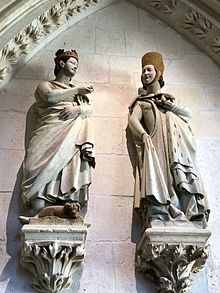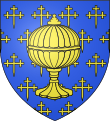Ferdinand III of Castile
| Ferdinand III | |
|---|---|
Alfonso X | |
| Born | 1199/1201 Monastery of Valparaíso, Peleas de Arriba, Kingdom of León |
| Died | 30 May 1252 (aged 50–53) Seville, Crown of Castile |
| Burial | , Seville, Spain |
| Consort | |
| Issue among others... | |
Castilian House of Ivrea | |
| Father | Alfonso IX of León |
| Mother | Berengaria of Castile |
Ferdinand III (Spanish: Fernando; 1199/1201 – 30 May 1252), called the Saint (el Santo), was
By military and diplomatic efforts, Ferdinand greatly expanded the dominions of Castile by annexing the crown of Guadalquivir river valley in the south of the Iberian Peninsula, establishing the boundaries of the Castilian state for the next two centuries. New territories included important cities such as Baeza, Úbeda, Jaén, Córdoba and Seville, that were subject of Repartimiento, given a new general charter and repopulated in the following years.
Ferdinand was
Early life
The exact date of Ferdinand's birth is unclear. It has been proposed to have been as early as 1199 or even 1198, although more recent researchers commonly date Ferdinand's birth in the summer of 1201.[2][3][4] Ferdinand was born at the Monastery of Valparaíso (Peleas de Arriba, in what is now the Province of Zamora).
As the son of Alfonso IX of León and his second wife Berengaria of Castile,[5] Ferdinand descended from Alfonso VII of León and Castile on both sides; his paternal grandfather Ferdinand II of León and maternal great grandfather Sancho III of Castile were the sons of Alfonso VII between whom his kingdom was divided. Ferdinand had other royal ancestors from his paternal grandmother Urraca of Portugal and his maternal grandmother Eleanor of England a daughter of Henry II of England and Eleanor of Aquitaine.[6]
The marriage of Ferdinand's parents was annulled by order of Pope Innocent III in 1204, due to consanguinity, but the legitimacy of the children was recognized.[7] Berengaria then took their children, including Ferdinand, to the court of her father, King Alfonso VIII of Castile.[8] In 1217, her younger brother, Henry I, died and she succeeded him on the Castilian throne with Ferdinand as her heir, but she quickly surrendered it to her son.
Alfonso of León considered himself tricked, and the young king had to begin his reign by a war against his father and a faction of the Castilian nobles. His and his mother's abilities proved too much for the king of Leon and his Castilian allies. Berengaria continued to be a key influence on Ferdinand, following her advice in prosecuting wars and even in the choice of a wife, Elisabeth of Swabia.[7]
Unification of Castile and León
When Ferdinand's father died in 1230, his will delivered the kingdom to his older daughters
Early in his reign, Ferdinand had to deal with a rebellion of the House of Lara.
Reconquest of al-Andalus
Since the

The crisis in the Almohad Caliphate, however, remained unresolved. In 1228, a new Almohad pretender, Idris al-Ma'mun, decided to abandon Spain, and left with the last remnant of the Almohad forces for Morocco. Al-Andalus was left fragmented in the hands of local strongmen, only loosely led by Muhammad ibn Yusuf ibn Hud al-Judhami. Seeing the opportunity, the Christian kings of the north – Ferdinand III of Castile, Alfonso IX of León, James I of Aragon and Sancho II of Portugal – immediately launched a series of raids on al-Andalus, renewed almost every year. There were no great battle encounters – Ibn Hud's makeshift Andalusian army was destroyed early on, while attempting to stop the Leonese at Alange in 1230. The Christian armies romped through the south virtually unopposed in the field. Individual Andalusian cities were left to resist or negotiate their capitulation by themselves, with little or no prospect of rescue from Morocco or anywhere else.
The twenty years from 1228 to 1248 saw the most massive advance in the
Ferdinand annexed some of his conquests directly into the Crown of Castile, and others were initially received and organized as vassal states under Muslim governors (e.g. Alicante, Niebla, Murcia), although they too were eventually permanently occupied and absorbed into Castile before the end of the century (Niebla in 1262, Murcia in 1264, Alicante in 1266). Outside of these vassal states, Christian rule could be heavy-handed on the new Muslim subjects. The range of Castilian conquests also sometimes transgressed into the spheres of interest of other conquerors. Thus, along the way, Ferdinand III took care to carefully negotiate with the other Christian kings to avoid conflict, e.g. the treaty of Almizra (26 March 1244) which delineated the Murcian boundary with James I of Aragon.
Ferdinand divided the conquered territories between the
The capture of Córdoba was the result of a well-planned and executed process whereby parts of the city (the Ajarquía) first fell to the independent almogavars of the Sierra Morena to the north, which Ferdinand had not at the time subjugated.[10] Only in 1236 did Ferdinand arrive with a royal army to take the Medina, the religious and administrative centre of the city.[10] Ferdinand set up a council of partidores to divide the conquests and between 1237 and 1244 a great deal of land was parcelled out to private individuals and members of the royal family as well as to the Church.[11] On 10 March 1241, Ferdinand established seven outposts to define the boundary of the province of Córdoba.
Domestic policy
On the domestic front, Ferdinand strengthened the
He took care not to overburden his subjects with taxation, fearing, as he said, the curse of one poor woman more than a whole army of Saracens.[13]
Death
Ferdinand III had started out as a contested king of Castile. By the time of his death he had delivered to his son and heir,
Ferdinand's death was attributed to a
He was
The symbol of his power as a king was his sword Lobera.
Patronage
Saint Ferdinand III | |
|---|---|
 Painting of St. Ferdinand III by Bartolomé Esteban Murillo (17th century) | |
| Honored in | Catholic Church |
| Canonized | 4 February 1671 by Pope Clement X |
| Feast | May 30 |
| Patronage | Cities: Seville, Aranjuez, San Fernando de Henares, Maspalomas, Pivijay Military: Spanish Army's Corps of Engineers |
Saint Ferdinand is the patron saint of Seville, Aranjuez, San Fernando de Henares, Maspalomas, Pivijay, and of several other localities. He is also the patron of the Spanish Army's Corps of Engineers,[19] and engineers generally.[20]
Since the establishment in 1819 of the
Family
First marriage

In 1219, Ferdinand married Elisabeth of Swabia (1203–1235).[a][24] She was the fourth daughter of Philip, Duke of Swabia, and Irene Angelina.[23] Their children were:
- Alfonso X (1221–1284), his successor[25]
- Frederick (1223–1277)
- Ferdinand (1225–1243/1248)
- Eleanor (born 1227), died young
- Las Huelgas
- Henry (1230–1303)
- Haakon IV of Norway, who had been intended as a bride for one of his brothers, that he abandoned his holy vows and married her. She died in 1262, childless.
- Sancho, Archbishop of Toledo and Seville (1233–1261)
- Manuel of Castile (1234–1283)
- Maria, died an infant in November 1235
Second marriage
After he was widowed, he married Joan, Countess of Ponthieu, before August 1237.[26] They had four sons and one daughter:
- Count of Aumale
- Eleanor (c. 1241–1290), married Edward I of England.[27]
- Louis (1243–1269)
- Simon (1244), died young and buried in a monastery in Toledo
- John (1245), died young and buried at the cathedral in Córdoba
See also
Notes
References
- ^ Bianchini 2012, p. 1.
- ^ Ansón 1998, p. 39.
- ^ Emmerson 2013, p. 215.
- ^ Ezquerra 2001, p. 284.
- ^ Linehan 2008, p. xvii.
- ^ Shadis 2010, p. xix.
- ^ a b Chisholm, Hugh, ed. (1911). . Encyclopædia Britannica. Vol. 10 (11th ed.). Cambridge University Press. p. 266.
- ^ Shadis 2010, p. 70.
- ^ Shadis 1999, p. 348.
- ^ a b Edwards 2001, p. 6.
- ^ Edwards 2001, p. 7.
- ^ Edwards 2001, p. 182.
- ^ Heckmann 1909.
- ^ Fernández de Castro Cabeza 1988, p. 277.
- ^ Menocal 2009, p. 47.
- ^ Reilly 1993, p. 133.
- ^ Roman Catholic Saints
- ^ Fitzhenry 2009, p. 6.
- ^ "Ceuta reúne por San Fernando a los Ingenieros con más solera" [Ceuta brings together the Engineers with the most tradition in San Fernando]. Spanish Ministry of Defence (in Spanish). 31 May 2011. Retrieved 5 August 2016.
- ^ Brewer's Dictionary of Phrase & Fable. Cassell Ltd.
- ISBN 978-84-7947-625-0.
- ^ "Orígenes de la ULL". ULL. Universidad de La Laguna (in Spanish). Archived from the original on 27 August 2016. Retrieved 5 August 2016.
- ^ a b Kinkade 2019, p. 8.
- ^ Bianchini 2019, p. 66.
- ^ Houben 2023, p. 80-81.
- ^ Johnstone 1914, p. 436.
- ^ Powicke 1991, p. 235.
Sources
- Ansón, Francisco (1998). Fernando III: Rey de Castilla y León (in Spanish). Palabra. ISBN 978-84-8239-233-2.
- Bianchini, Janna (2012). The Queen's Hand: Power and Authority in the Reign of Berenguela of Castile. University of Pennsylvania Press. ISBN 978-0-8122-0626-5.
- Bianchini, Janna (2019). "The 'Infantazgo' in the Reign of Alfonso VIII". In Smith, Damian J.; Lincoln, Kyle C.; Gómez, Miguel (eds.). King Alfonso VIII of Castile: Government, Family, and War. Fordham University Press. pp. 59–79.
- Brewer, Ebenezer Cobham. Brewer's Dictionary of Phrase and Fable. New York: Harper and Bros.
- Edwards, John (2001). Christian Córdoba: The City and Its Region in the Late Middle Ages. University of Central Arkansas.
- Emmerson, Richard K., ed. (2013). Key Figures in Medieval Europe: An Encyclopedia. Taylor & Francis. ISBN 978-1-136-77518-5.
- Ezquerra, Jaime Alvar, ed. (2001). Diccionario de historia de España. Ediciones AKAL. ISBN 978-84-7090-366-3.
- Fernández de Castro Cabeza, María del Carmen (1988). The Life of the Very Noble King of Castile and León, Saint Ferdinand III. Mount Kisco, N.Y.: ISBN 978-1877905094.
- Fitzhenry, James (2009). "Saint Fernando III, A Kingdom for Christ". Catholic Vitality Publications.
- González, Julio. Reinado y Diplomas de Fernando III, i: Estudio. 1980.
- Heckmann, Ferdinand (1909). . In Herbermann, Charles (ed.). Catholic Encyclopedia. Vol. 6. New York: Robert Appleton Company.
- Houben, Hubert (2023). "How did the Teutonic Knights finance the construction of Montfort castle". In Khamisy, Rabei G.; Lewis, Rafael Y.; Shotten-Hallel, Vardit R. (eds.). Exploring Outremer Volume I: Studies in Medieval History in Honour of Adrian. Routledge. pp. 59–86.
- Johnstone, Hilda (1914). "The County of Ponthieu, 1279–1307". The English Historical Review. 29 (115). Oxford University Press: 435–452. .
- Kinkade, Richard P. (2019). Dawn of a Dynasty: The Life and Times of Infante Manuel of Castile. University of Toronto Press.
- Linehan, Peter (2008). Spain, 1157-1300: A Partible Inheritance. Wiley.
- Menocal, Maria Rosa (2009). The Ornament of the World: How Muslims, Jews, and Christians Created a Culture of Tolerance in Medieval Spain. Boston: Little, Brown. ISBN 978-0-316-09279-1.
- Powicke, Frederick Maurice (1991). The Thirteenth Century, 1216–1307. Oxford University Press.
- Reilly, Bernard F. (1993). The Medieval Spains. Cambridge University Press. ISBN 978-0-521-39741-4.
- Shadis, Miriam (1999), "Berenguela of Castile's Political Motherhood", in Parsons, John Carmi; Wheeler, Bonnie (eds.), Medieval Mothering, New York: Taylor & Francis, ISBN 978-0-8153-3665-5
- Shadis, Miriam (2010). Berenguela of Castile (1180–1246) and Political Women in the High Middle Ages. Palgrave Macmillan. ISBN 978-0-312-23473-7.
- Saint Ferdinand at the Christian Iconography web site



